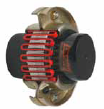The following details is necessary when producing a Grid coupling assortment:
Description of motor or engine, the horse energy (or KW), and RPM at slowest coupling velocity while underneath load
Description from the driven products
Shaft and keyway sizes as well as the type of fit for driver and driven gear (clearance or interference)**
Shaft separation (BSE)
Physical area limitations (see Application Worksheet)
Identify what the environmental circumstances will likely be, such as temperature, corrosive problems, interference from surrounding structures, etc.
By default, sizes 1020 – 1090 are going to be clearance fit, sizes 1100 – 1200 is going to be interference fit.
** Machines all bores and keyways to meet the dimensional and tolerance specifications per ANSI/AGMA 9002-B04 for inch bores, or ISO 286-2 for metric bores.
Standard grid couplings include two grid hubs, a grid spring, plus a cover assembly. When the shaft separation requires a spacer style coupling, the coupling will consist of two shaft hubs,  two spacer hubs, a grid spring, along with a horizontal cover assembly.
two spacer hubs, a grid spring, along with a horizontal cover assembly.
Formulas Made use of To Calculate Torque:
Application Torque (in-lbs) = ( horse power x 63025 ) /RPM
Application Torque (Nm) = ( horse energy x 9550 ) /RPM
Assortment Torque = Application Torque x Support Aspect
High Peak Loads and Brake Applications
For applications where substantial peak loads or higher braking torques might be current, the next extra information and facts will likely be essential:
System peak torque and frequency
Duty cycle
Brake torque rating
The choice torque formula is much like the formula shown above except the application torque need to be doubled before applying the services component.
Application Torque (in-lbs) = ( horse energy x 63025 ) /RPM
Application Torque (Nm) = ( horse electrical power x 9550 ) /RPM
Choice Torque = two x Application Torque x Service Element
Actions In Selecting A Grid Coupling
Step 1: Figure out the application torque working with the formula shown over.
Phase two: Decide on the Service Aspect from your charts .
For applications not displayed utilize the chart proven towards the ideal. Establish the Assortment Torque making use of the formula proven over.
Step three: Employing the choice torque as calculated, refer for the Overall performance Chart
Stage 4: Compare the maximum bore for that size selected and make sure the necessary bore sizes usually do not exceed the maximum allowable. If your needed bore dimension is greater, stage up to the subsequent dimension coupling and verify to view if your bore sizes will fit.
Stage 5: Applying the chosen coupling dimension, compare the bore and keyway sizes
Stage 6: Make contact with your local industrial supplier with the portion numbers to location sizes using the charts for UPC component numbers.